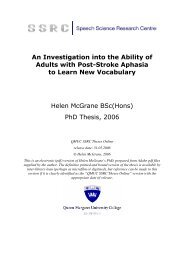QM News 60 (pdf 1305KB) - Queen Margaret University
QM News 60 (pdf 1305KB) - Queen Margaret University
QM News 60 (pdf 1305KB) - Queen Margaret University
Create successful ePaper yourself
Turn your PDF publications into a flip-book with our unique Google optimized e-Paper software.
PAGE 02 - MAIN FEATURE<br />
BUILDING A SUSTAINABLE CAMPUS<br />
When we hear the word<br />
“sustainability”, what does it actually<br />
mean to most of us - probably not<br />
much! But to Nick Bowen, from Ian<br />
White Associates, the landscape<br />
architects responsible for designing<br />
the grounds around <strong>QM</strong>UC's new<br />
campus at Craighall, East Lothian, it<br />
means a great deal. Nick has<br />
responsibility for ensuring that the<br />
grounds in the new campus<br />
development fit with <strong>QM</strong>UC's vision<br />
for the project - to “develop a<br />
sustainable community for learning<br />
and life”.<br />
Nick explains: “Sustainability is all about<br />
minimising the impacts that<br />
development will have on the<br />
environment, and maximising the<br />
potential environmental gain. For<br />
instance, designing buildings which<br />
utilise natural light and ventilation<br />
decreases their requirement for<br />
electricity, whilst creative solutions to site<br />
drainage can also result in creation of<br />
ecologically valuable wetland.”<br />
When the decision was made to move<br />
to East Lothian, students, staff and the<br />
local community were consulted to find<br />
out what was important to them and<br />
what they would like to see incorporated<br />
into the design. The overwhelming<br />
request that came back was for “a<br />
green environment in which to live and<br />
work”.<br />
Building a sustainable campus impacts<br />
on every aspect of design and<br />
construction. From the materials used,<br />
to the design of the buildings and the<br />
exterior landscape, everything must be<br />
considered from an environmental<br />
perspective. So what sort of things will<br />
Nick be incorporating into the landscape<br />
design? Well, in addition to providing<br />
homes for about 800 students, homes<br />
will be provided for a diverse variety of<br />
wildlife. A big part of creating an<br />
environmentally-friendly landscape is<br />
ensuring that as many opportunities as<br />
possible are created for local indigenous<br />
wildlife to share the site with people.<br />
Four of the most important types of<br />
lowland Scottish habitat - wetland,<br />
woodland, meadow and hedgerow - will<br />
be incorporated into the design.<br />
Woodland will provide screening from<br />
traffic noise and a green transport policy<br />
will ensure that the core of the campus<br />
will be a car-free zone, making it a haven<br />
from traffic congestion and pollution.<br />
Hedgerows and meadowland will<br />
provide additional habitats and will<br />
create buffer zones to separate human<br />
and wildlife traffic. As well as natural<br />
habitats created by clever landscape<br />
design, Nick has also made provision for<br />
a few other, man-made (but no less<br />
popular) homes to encourage some<br />
more unusual local residents to move in<br />
- pipistrellus pipistrellus, or the common<br />
pipistrelle as he is better known, is one<br />
local resident who will find he has fourstar<br />
accommodation ready and waiting -<br />
in the form of a number of strategically<br />
placed bat boxes! In fact both these and<br />
some of our feathery friends will find a<br />
range of ready-made roosting boxes<br />
available for immediate occupancy.<br />
Within the campus woodland planting<br />
will also be nesting opportunities for the<br />
likes of hedgehogs and insects, in log<br />
and brash piles.<br />
The wetland habitat to be created will be<br />
an environmentally-friendly addition to<br />
the site for a number of reasons. No<br />
ordinary pond, this will be part of a<br />
“sustainable urban drainage system” or<br />
SUDS for short. The pond will capture<br />
rainwater draining off roofs and paved<br />
areas, holding it back on site rather than<br />
contributing to downstream flooding.<br />
So, as well as providing a solution to the<br />
problem of excess surface water, there<br />
will be an attractive feature that will<br />
provide a pleasant spot which can be<br />
used for recreation, and will be an<br />
excellent habitat for wildlife.<br />
The provision of an area of decking and<br />
appropriate signage will ensure that<br />
there is an educational benefit to the<br />
pond. This will provide a facility where<br />
local schools can come to teach<br />
children about the environment and the<br />
wonderful range of creepy crawlies that<br />
inhabit the pond area - everything from<br />
the reclusive common newt to sparkly<br />
damselflies and chirping linnets and<br />
bullfinches.<br />
According to Nick, providing as wide a<br />
range of habitats as possible is<br />
important because it “helps to replace<br />
some of the local diversity which has<br />
been lost from our intensively farmed<br />
countryside, and gives the campus a<br />
further function besides accommodating<br />
the human activities to which it will be<br />
home”. So when <strong>QM</strong>UC moves to<br />
Craighall in 2007, there will be more<br />
than just students, staff and the local<br />
community sharing the campus. There<br />
will be a diverse range of plant and<br />
animal life too - <strong>QM</strong>UC really is<br />
“developing a sustainable community for<br />
learning and life”!<br />
Main picture:<br />
An example of a bat box<br />
Inset:<br />
Nick Bowen of Ian White Associates

















